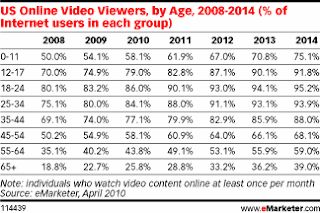eMarketer estimates that 66.7 percent of all U.S. Internet users -- approximately 147.5 million people -- watch video content online each month. By 2014, viewership will rise to 77 percent of Internet users, or 193.1 million people.
During the same period, online video advertising spending will increase from $1.4 billion to $5.2 billion.
Over the next five years, consumers will become more comfortable watching all forms of video content -- long and short, professional and amateur -- on their Internet-connected mobile phones, laptop PC, desktop PC, tablets and connected TV sets.
But by 2014 the current "monthly viewership" rating will likely be outdated. Daily or weekly viewing will be the relevant metric, with usage perhaps measured in minutes and hours spent viewing video content each day.
Already, 29 percent of Internet users under 25 say they watch all or most of their TV programs online. A closer look at viewership rates by age shows classic early-adopter patterns -- with 18- to 34-year-olds exhibiting the highest viewership.
eMarketer forecasts significant growth in video viewers across all age groups -- in part because of how easy it is to share content online. However, the amount of time baby boomers and seniors watch online video will be smaller compared with their younger counterparts.
